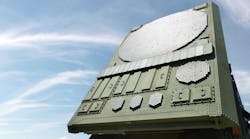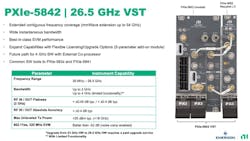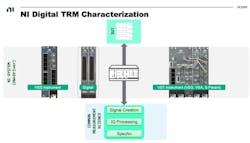What you’ll learn:
- Scanned phased arrays and factors affecting radar system performance.
- Definition and types of transmit/receive modules.
- New measurements for digital TRMs.
The first scanned phased arrays used a single transmitter and receiver connected to all antenna elements through phase shifters. Today’s active electronically scanned arrays (AESAs) employ many solid-state transmit/receive modules (TRMs), each connected to an antenna element.
Rearchitecting the AESA with TRMs was made possible by advances in semiconductor technology during the 1980s, including MESFETs and JFETs for transmit power amplification, and gallium arsenide (GaAs) for low-noise receive amplification. Size, cost, and power consumption of TRMs have been reduced over time, creating potential for future commercial applications.
Radar Beamwidth vs. Array Size and Number of TRMs
One of the primary factors affecting radar system performance is the beamwidth of the antenna. Assuming the antenna element used with a TRM is a half-wave dipole, this would spread the transmitted energy over a 78-degree beamwidth, with similar performance on receive.
While that might be acceptable for gross detection of aircraft or other objects, such broad beamwidth would mean that radar returns are received from a wide range of “targets'' and “clutter” within the beamwidth, including undesired aircraft, foliage, and other elements. Narrower beamwidths would be more beneficial for higher performance.
Increasing the AESA size by using more TRMs simultaneously achieves narrower beamwidth and higher gain. Beamwidth is inversely proportional to array size, while gain is directly proportional to array size.
As a result, larger arrays with increasing numbers of TRMs would provide higher performance with the ability to pick out single targets at longer range and reject the effects of clutter. Although large arrays may be desired for increased radar performance, it’s easy to see that there are limitations on size due to limited available “real estate,” as well as total cost for multiple TRMs (including test).
Definition and Types of TRMs
A TRM provides a range of functionality in a radar system:
- High power amplification (HPA) for the transmitter
- Low-noise amplification (LNA) for the receiver
- Digitally controlled phase shifting
- Digitally controlled attenuators to set power levels in the TRM
Figure 1 shows a high-level block diagram of an analog TRM. Newer digital TRMs (DTRMs) receive digital data from the radar system and convert back to digital on the receive side. Often, this leverages newer “Direct Sampling” techniques to convert received RF to digital as close to the antenna as possible, enabling radar processing in the DTRM.
A high-level block diagram of two DTRMs with antennas is illustrated in Figure 2. AESAs configured with DTRMs offer advantages such as reduction of module weight and size due to increased digital vs. analog content. However, the evolution to DTRMs also presents new challenges. Foremost among them is how to test DTRMs from “RF to bits” in development, verification, and production test phases.
What’s Required to Test a TRM?
Since their inception, analog TRMs have been tested using systems of vector network analyzers (VNAs), vector signal generators (VSGs), and vector signal analyzers (VSAs). Depending on the stage in the DTRM development/verification/production cycle, each of these instruments can be used to extract different and varying levels of measurement data to support test objectives.
VNAs fundamentally provide small signal S-parameter measurements such as gain, input match, and output match, and enable calibration of the TRM using a range of transmit and receive gain and phase settings. In addition to CW measurements, some VNAs can be useful for pulsed measurements, enabling measurement of semiconductor devices in the power amplifier that are unable to operate at 100% duty cycle.
The pairing of VSG with VNA provides added measurement capability that will be required for some stages of testing. These instruments allow the test engineer to excite the TRM with a customizable waveform and measure the signal on the output. A wide range of potential measurements are enabled using these instruments, including noise figure (NF), adjacent channel power (ACP), error vector magnitude (EVM), third-order intercept (TOI), power-added efficiency (PAE), and others.
As described in the previous section, DTRMs no longer have an analog input/output for testing, so traditional instruments have limited utility. New solutions matching the mixed-signal nature of DTRMs are required, with capability to make new measurements that are analogous to VNAs, VSGs, and VSAs.
New Measurements for DTRMs
The major change in the transition from analog TRMs to DTRMs is replacement of the RF port from the radar with a digital serial and/or parallel port. Measurements similar to traditional measurements are still required, but new means of emulating digital signals from the radar are needed. While traditional VNA RF in/RF out measurements no longer exist for DTRMs, analogous measurements with Digital in/RF out and RF in/Digital out are now possible.
Assuming that digital data is supplied to the DTRM to activate a specific RF frequency/phase/amplitude output and sequenced to the next RF state, it’s possible to construct swept measurements similar to VNA S21 measurements. Likewise, assuming that RF at a specific RF state is supplied to the DTRM and sequenced to the next RF state, swept measurements akin to VNA S12 measurements are possible. If desired, output match (S22) could also be measured using traditional RF techniques.
Traditional VSG/VSA measurements could be emulated using similar techniques. Analogs to traditional TX measurements such as Power, ACP, EVM, TOI, PAE, and others could be constructed using the appropriate digital data into the DTRM and measuring RF with a VSA. Likewise, analogs to traditional RX measurements such as BER/BLER and NF could be constructed using the appropriate RF state and data stream into the DTRM and measuring data on the digital side.
The Value of PXI for DTRM Test
Today’s modular measurement solutions enable the user to configure multifunction instruments in a single chassis, matching the mixed-signal Digital+RF requirements for DTRMs. A combination of serial and parallel data modules along with RF modules meets unique test requirements for the mixed-signal digital/RF nature of the DTRM. When paired with CW and pulsed power-supply modules, the result is a compact solution offering a unique set of measurements fitting DTRM test requirements.
PCI eXtensions for Instrumentation (PXI) is the leading modular measurement solution in the market, and a wide range of modules matching DTRM test needs are available. National Instruments (now NI, an Emerson company) founded PXI in 1997, and has developed a wide range of modular instruments matching industry requirements since that time. Relative to DTRM test requirements, this includes:
- Vector signal transceiver (VST) modules combining both VSG and VSA functionality in a small form factor.
- VNA modules, including the newest version that enables combined VST and VNA measurements on a single set of ports.
- Source measurement unit (SMU) modules to provide CW and pulsed power to the system under test (SUT).
- Tight timing synchronization of all modules in the chassis using the PXI backplane.
For example, the new PXIe-5842 VST instrument is capable of RF measurements from 30 MHz to 26.5/54 GHz. Options for 2 and 4 GHz of instantaneous bandwidth (IBW) exceed typical bandwidths used for modern radars. Measurement algorithms are available to accelerate implementation of customizable measurements, including NF, ACP, EVM, TOI, PAE, and other parameters (Fig. 3). Optional addition of the PXIe-5633 module enables measurement of DTRM output match (S22) as needed.
When paired with additional NI PXI modules for high-speed serial (HSS), digital control, and power supply, a single-chassis solution can be assembled that fits complex measurement requirements for mixed-signal digital/RF DTRMs (Fig. 4).
Conclusion
Modern AESA-based radars use numerous TRMs to achieve high performance with narrow beamwidths and high gain. Each of the TRMs in the AESA must be tested in development, verification, and production to verify performance in design and guarantee performance on the battlefield.
Test solutions for legacy analog TRMs have consisted of VNAs, VSGs, and VSAs, but newer DTRMs require evolved capability to transmit and receive digital data at the same time as RF measurements. NI’s PXI instruments have the ability to meet measurement requirements of DTRMs, enabling users to build a custom mixed-signal instrument using available VST and HSS modular instruments with power supplies and VNAs to match overall test requirements.




